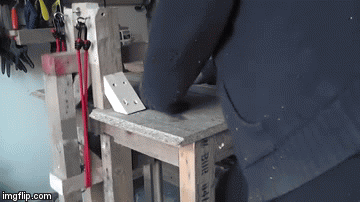Introduction: Pedal Powered Table Saw Experiment
I've been thinking about the possibilities of human powered tools for a while and so thought I'd try an experiment. I quickly whipped up a simple table and attached a Japanese Ryoba saw to it just to see how it would cut. The reason I'm making sure I put the word "experiment" in the title is because its a very rough build and definitely needs improvement. I have a video on YouTube showing it in action and what it can do and also some instructions below on how I made it. I hope you enjoy it!
Step 1: Materials Needed
The materials needed for this build will vary on how you build the table and the mechanism for the saw, there's many alterations (and I'm certain, improvements) that could be made to this design. I've included a simple PDF exploded diagram to give more of a demonstration of how the saw is constructed. Below is a list of what I used:
Materials:
- Around 9m (29' 6 3/10") of construction lumber or cross beam pallet wood (used in this build).
- Around 2.6m (8' 6 4/10") of pallet wood.
- A flat surface, wood or plastic, around 70cm (27 9/16") by 60cm (23 5/8").
- 2 X 60cm (23 5/8") bungee cords.
- Japanese Ryoba saw.
- 95cm (37 3/8") length of conduit or strong dowel/pipe.
- 1m (39 3/8") length of rope at least.
- Around 100 wood screws approx. 4cm - 6cm long (1 9/16" - 2 3/8").
- A bolt, 10cm long and 6mm wide (3 15/16" long and 3/16" wide) with 2 corresponding washers, 1 nut and 1 wingnut.
- 1 long wood screw, around 8cm long (3 1/8")
- 2 screw in eyelets and 1 screw in hook.
- 2 hinges.
Tools:
- Drill or brace
- 2mm (1/16") wide pilot hole bit.
- 10mm (3/8") wide bit for countersinking (or a countersinking bit if you have one).
- 25mm wide bit (1").
- 6mm wide metal bit (3 15/16")
- Cross cut wood saw.
- Medium sized chisel.
- Mallet.
Attachments
Step 2: Making the Table
This part of the project can be whatever you want it to be, I opted to make my table about the same height as my workbench so that I could clamp it to my workbench for sturdiness. The legs are 85cm long X 7cm wide X 4.5cm deep (33 7/16" X 2 3/4" X 1 3/4"). The two shorter stretchers, made of the same wood, are 34cm (13 3/8") long and the two longer stretchers are 60cm (23 5/8") long.
I attached the legs to the stretchers first with 2 screws from each end of each stretcher. I then placed the 60cm X 70cm (23 5/8" X 27 9/16") wood board (unused flooring sheet) on top and screwed down from the top into the stretchers, using around 5 screws per stretcher.
Step 3: Making the Frame for the Saw
When I was thinking about the design of this project a Japanese Ryoba saw came into my mind for a few reasons. Firstly it has a thin blade and so would (hopefully) move smoothly through the wood, secondly it can pass through the wood without obstruction as this style of saw has no "backbone" like many saws do and thirdly it makes the construction of the project easier because Japanese saws cut on the pull stroke.
I clamped the frame for the saw down on the table to keep it square as I was screwing it together, the top and bottom lengths are 38cm (14 15/16") long and the vertical length is 27cm (10 5/8") long. I screwed them together and then made two 45 degree braces for each corner to keep it as square as possible, once it shifts out of square the saw would start to bend and get caught in the wood.
I then sawed a thin slot in the top length for the top of the saw to slide into, I screwed two pieces of wood on either side which dug into the saw teeth, holding it in place as you can see in the photo. This saw also has a hole at the top of it and so I decided to drive a long screw into the end of the wood which then goes through the hole in the saw, holding it in even more.
To hold the handle of the saw to the bottom length of the frame I made an indent for it to slide into. I then attached a piece of wood on the outside with screws to hold it in. Whilst I was using it this wasn't quite enough and the saw started to twist, so to hold it temporarily I used electrical tape as you can see in the photo! This part of the design clearly needs re thinking and I wouldn't advise electrical tape for a permanent fix!
Step 4: Keeping the Saw Frame Straight
The next dilemma to overcome was that of the straightness of the saw. I decided to use a piece of conduit (95cm or 37 3/8") and drill a hole straight down through the frame, the table and the stretcher. I added an extra stretcher underneath and drilled through that too, giving the conduit more stability.
This accounted for the side to side movement of the saw but not for the twisting movement. To overcome this I built an enclosure around the path of the saw frame. On the top of the table I pulled the saw frame up to its highest point and built the enclosure accordingly. The two vertical lengths are 26cm long (10 1/4") and the short horizontal section is 7cm long (2 3/4"), I had to make some 45 degree braces to hold it firm, all screwed in.
Twist still remained a problem when the saw was at its lowest point, putting two more lengths underneath the stretcher to keep the saw frame steady seemed to fix this problem. After I cut the lengths at 35.5cm long (14") I screwed them into the lower and upper stretcher and the problem was fixed.
Step 5: Securing the Bungee Cords for the Saw to Spring Back
The enclosure for the saw frame was conveniently positioned to allow the bungee cords somewhere to hook onto. I screwed in two large eyelets to the highest point of the enclosure and hooked on some bungee cords which then went underneath the saw frame. In order to stop the bungee cords flying off I also screwed a large hook in the bottom of the saw frame to hold the cords in place.
To secure the conduit in place I drilled straight through it and also through the wood behind it, a long bolt with two washers and a wing nut was all that was needed to keep it in place.
Step 6: Making the Pedal and Attaching the Rope
Now that the method of springing back up was in place I just needed to add a pedal for the down stroke of the saw. This is the cutting direction so its important to have the pedal in a position in which you can push down enough to cut through the wood.
To make the pedal I cut three lengths of pallet wood to 55cm (21 5/8") and another three to 30cm (11 13/16"). The longer lengths were then screwed into the shorter lengths to make the pedal, as per photo. In order to keep the pedal in place I used two hinges which attached to the bottom of the pedal to the legs.
I tied one end of the rope to the lower length of the saw frame and then lifted the pedal up and tied the other end onto it. My foot would be on the left side of the pedal mostly because it is directly under where the rope is attached to the saw frame. Right under where my foot would be I attached a block of wood to hit the ground when the pull down motion was complete.
Step 7: Cut Some Wood!
Of course I had to try it out right after making it and although it did cut wood there was a certain technique to it. I found on every up stroke of the saw I had to pull the wood away from the blade a little to stop it becoming caught and then push it back in on the down stroke. This became less of a problem the more I used it.
Is it a final product? Not at all, but it was an interesting experiment and a really fun thing to use. I think its a good basis for perhaps a more sophisticated build in the future.
I hope you enjoyed this instructable, please head over to my YouTube channel if you'd like to check out my other projects and feel free to ask questions or give suggestions in the comments below! Thank you.

Third Prize in the
Survival Ready Contest















